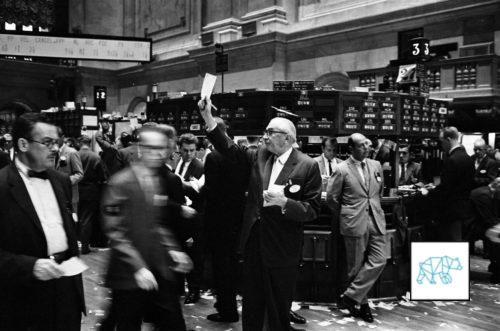
17 Aug What drives oil? Financial Markets.
Points to be taken from this read
Before and after world economic slowdown, there were observable increases in correlations between commodity prices.
There is a negative correlation between the USD and crude oil.
Stocks and crude oil prices tend to move in the same direction during financial crises and recovery.
Bond prices and interest rates move in opposite directions. U.S. Treasury bond prices and crude oil prices would tend to move in opposite directions in times of changing economic conditions.
Inverse relationship between the exchange value of the dollar relative to other currencies and crude oil prices.
Disclaimer
Most of the information here comes from the U.S. Energy Information Administration’s website (EIA) and some from Wikipedia. I am not pretending to come up with all this information myself. The only thing I did was go through the information and put together pieces of it to make it easier to understand and access for myself. This, I want to share with you and I hope it benefits you in some way. All the praise goes to the good people that put this up on the EIA and Wikipedia website.
Please go over to these respective websites for a lot more information:
EIA on the balance of ‘What drives Crude Oil?’ financial markets
https://www.eia.gov/finance/markets/crudeoil/financial_markets.php
Keeping it simple
As I tried explaining in the disclaimer this post is just going to be the summarization of ‘facts’ I have found on the internet. Sort of like a cheat sheet for anything on the financial markets that are involved with crude oil. Above you can find the sources for the information listed here so head on over and look up more details if you wish.
So here it goes…
Market participants
- Market participants not only buy and sell physical quantities of oil, but also trade contracts for the future delivery of oil and other energy derivatives.
- One of the roles of futures markets is price discovery, and as such, these markets play a role in influencing oil prices.
- Oil market trading activity involves a range of participants with varying motivations, even within individual participants.
- Some, such as oil producers and airlines, have a significant commercial exposure to changes in the price of oil and petroleum-based fuels, and may seek to hedge their risk by buying and selling energy derivatives. For example, an airline may want to buy futures or options in order to avoid the possibility that its future fuel costs will rise above a certain level, while an oil producer may want to sell futures in order to lock in a price for its future output.
- Banks, hedge funds, commodity trading advisors, and other money managers-who often do not have interests in trading physical oil-are also active in the market for energy derivatives to try to profit from changes in prices.
- In recent years, investors have also shown interest in adding energy and other commodities as alternatives to equity and bond investments to diversify their portfolios or to hedge inflation risks.
- Every transaction must involve both a buyer and a seller, and the desired “long” buyer and “short” seller positions of those with direct commercial interests in the oil market do not necessarily equal one another.
- Banks, hedge funds, and other “non-commercial” investors can add liquidity to futures and derivative markets by taking the other side of transactions with commercial participants.
- On the other hand, concerns have been raised that non-commercial commodity trading and investment may “use up” liquidity and amplify price movements, particularly at times when momentum is running strongly in a particular direction.
Higher interest in commodities
- Activity in commodity exchange contracts has risen in recent years. One measure of activity in futures markets is open interest on exchanges, which indicates the number of contracts in a trading session that have not been settled or closed.
- Open interest (click here to find out what it is) on exchange-traded crude oil futures contracts increased substantially over the past decade, as measured by the New York Mercantile Exchange (NYMEX) , the main commodities exchange for energy products in the United States.
- Both commercial participants (those that have a direct interest in physical oil production, consumption, or trade) and non-commercial investors (money managers and funds that are interested in trading contracts for investment and diversification purposes) have shown increased trading activity.
- Care must be taken in interpreting these data, however, because the vast majority of positions are held in the less transparent over-the-counter (OTC) market rather than on exchanges.
- In addition to futures contracts, another way for market participants to invest in crude oil is through the buying and selling of options contracts.
- Options allow for investment exposure with limited potential for losses and provide an insurance-like instrument against adverse commodity price movements.
Activity publications
- The Commodity Futures Trading Commission publishes a weekly activity report on oil trading that occurs on exchanges (e.g., NYMEX), the Commitment of Traders Report .
- In this report, the activities of multiple trading categories are detailed, including physical participants (producers, merchants, processors, and end users), money managers (usually hedge funds or other sophisticated traders), and swap dealers (traditionally investment banks or commodity broker/dealers).
- On a net basis (subtracting short positions from long positions), physical participants tend to be net short while traders in the money managers category tend to be net long.
- In this report, the activities of multiple trading categories are detailed, including physical participants (producers, merchants, processors, and end users), money managers (usually hedge funds or other sophisticated traders), and swap dealers (traditionally investment banks or commodity broker/dealers).
- During the world financial crisis that occurred in the latter half of 2008 and 2009, markets saw a dramatic increase in the correlation between crude oil and other commodities as demand decreased for raw materials.
- However, both before and after the world economic slowdown, there were observable increases in the correlations between commodity prices. At the same time as this rise in correlations was a rise in interest in general commodity exposure.
- A growing number of investors have gained exposure to commodities by investing in index funds-market instruments that provide exposure to baskets of commodities.
- These index funds usually establish shares of various energy and other commodities to provide diversity across a range of commodities.
- Also, exchange traded funds (ETFs)-which can be bought and sold throughout the day like individual common stocks-are an increasingly popular means for investors, including individuals, to gain exposure to commodities as an asset class.
Complex matters
- Correlation is not the same as causation, however, and the relationship between crude oil and other financial markets is complex.
- Even with observed movements in correlation levels, influences between crude oil price changes and changes in values of other asset classes are unclear.
- For example, it is possible that high correlations are due to more primary relationships with a third common factor, such as economic growth expectations.
- Another complicating factor is that these relationships and their strength vary over time. Analysts continue to work to better understand the connections between these markets.
Index funds
- Most index funds are “long only” funds whose value will increase only when the prices of the underlying commodities rise.
- Investors in such instruments expect commodity prices to rise; money is lost if the values of the underlying commodities in the index decrease.
- Many of the managers of index-style investments do not trade the individual components of an index on a daily basis; instead, they buy and hold these investments over periods of months or years,
- rolling contracts forward to avoid physical delivery.
Additional info
- Some market observers believe that increased trading activity by investors and long-only index funds in oil markets has had a significant impact on the energy price formation process.
- Although a growing body of research by academics and securities market analysts examines this issue, no definitive conclusion either proving or disproving a causal linkage between non-commercial trading and large energy price swings over the past few years has been reached.
- Because the vast majority of positions are held in the less transparent OTC derivatives market, however, analysis that relies only on readily available data from the transparent portion of the market may offer only limited insights.
- Additional data and analysis are needed to better understand the relationship between energy derivatives trading and price movements. In addition, the global nature of trade in energy-related derivatives adds to the challenges of analyzing trading activity.
Other financial markets
- Prior to 2007, stocks, bonds, and exchange rates showed only infrequent, fleeting correlations to oil futures prices.
- In contrast, the price of crude oil showed positive correlations with stocks from 2008–2010.
- Negative correlations with the value of the U.S. dollar during most of late-2007 to the present.
- And more irregular but often negative correlations with bond prices during 2008–2010.
- For each asset class, there are financial, physical, and common underlying economic factors-such as the economic downturn and recovery-that could be influencing these more significant correlations.
- Financial factors include developments such as the growing interest over the last decade in crude oil as an investment asset.
- This investment interest has altered the financial money flow into and out of commodities.
- Physical crude oil markets can also be influenced by outside factors.
- Exchange rates and economic factors play a role in crude oil production and consumption, possibly leading to price correlations.
Stocks
- Stocks have traditionally been the largest investment market. Economic conditions can cause prices for stocks and commodities, including oil, to move higher or lower together.
- As macroeconomic conditions improve (or worsen), earnings for companies increase (or decrease)
- and demand for commodities as raw materials rise (or fall) as well.
- Economic expectations are one possible reason why a positive correlation was observed during 2008–2010 between the S&P 500, a benchmark for stock markets, and crude oil, one of the most heavily traded commodities in the world.
- In addition, there were significant changes in the level and appetite for risk during 2008–2010.
- Over the past decade, crude oil has shown similar risk/return characteristics to stocks. As a result, during periods where risks were rising significantly (during the financial crisis) and then abating (during recovery), stocks and prices for crude oil and other commodities could tend to move in the same direction.
Bonds
- As economic conditions improve (or worsen), interest rates on government bonds will tend to rise (or fall).
- Since bond prices and interest rates move in opposite directions, U.S. Treasury bond prices and the price of crude oil would also tend to move in opposite directions in times of significantly changing economic conditions.
- In addition, bonds, the second-largest investment market, are often viewed as lower-risk investments than stocks, albeit with lower average returns.
- As an asset class, bonds are generally less volatile and carry a lower chance of losing principal.
- U.S. Treasury bonds, in particular, are usually considered a riskless investment.
- As investors become worried about future returns in higher risk assets, such as stocks and commodities, they tend to increase allocations to bonds in their portfolios.
Currencies
- Several hypotheses have been offered that tend to support an inverse relationship between the exchange value of the dollar relative to other currencies and crude oil prices.
- The first is simply that because oil benchmarks are traditionally priced in U.S. dollars, a depreciation of the dollar decreases the effective price of oil outside the United States.
- This decreased cost may increase consumers’ demand for oil, adding upward pressure to prices.
- A second potential reason is that U.S. dollar depreciation will decrease the effective profits of non‑U.S. producers, when converted into foreign currencies.
- To counteract this, these countries may target higher dollar prices of oil to maintain real revenue, budget levels, and purchasing power in world markets.
- Dollar depreciation also reduces the returns on dollar-denominated assets, when measured in foreign currencies, which may increase the attractiveness of foreign investing in commodities like oil.
- Commodity investment may also become more attractive to U.S. investors as a hedge against inflation if dollar depreciation tends to increase expectations of greater inflation.
- Finally, a rise in oil prices also expands the U.S. trade imbalance, which can put additional downward pressures on the dollar, again yielding a negative correlation albeit with causation going in the reverse direction.
- Despite these many possible explanations, the actual correlation between oil prices and exchange rates has not been stable over time, and was close to zero for more than half of the last decade.
Thanks for reading
I hope this post helps to make the role of the financial markets in relation to oil prices more clear.
If you like what I’m doing here please leave a quick comment. It will be much appreciated. Trolls are still welcome as well. And subscribe to my newsletter if you like.





No Comments